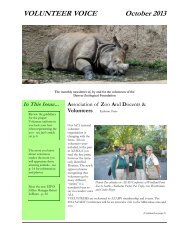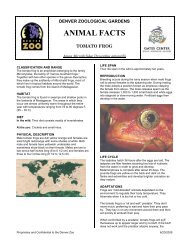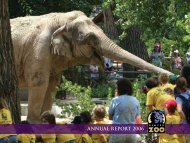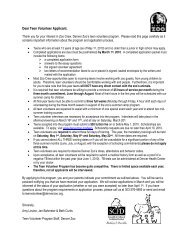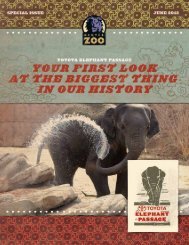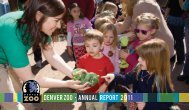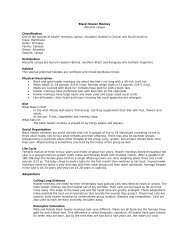2008 Annual Report - Denver Zoo
2008 Annual Report - Denver Zoo
2008 Annual Report - Denver Zoo
- No tags were found...
Create successful ePaper yourself
Turn your PDF publications into a flip-book with our unique Google optimized e-Paper software.
far left copperband butterflyfishmiddle turaco pairleft sea lion Nickright mangabey baby and motherfecal samples for hormone analysis. Trained <strong>Denver</strong> <strong>Zoo</strong> docents assisted withtime consuming data collection which will continue for the next two years.scaly successesDuring <strong>2008</strong>, Tropical Discovery staff created a new exhibit to accommodatelarger species of tropical reptiles by replacing three small reptile exhibits near theentrance to Tropical Discovery. The exhibit’s first residents were Philippine sailfinlizards, rare and threatened three to four-foot long arboreal lizards. The male ofthis species sports a huge sail flap extension on its tail. They are agile swimmersusing water as an escape route by dropping from the trees when threatened.Once the exhibit was constructed, keepers fabricated an artificial pool and ahorticulturist furnished live plants and painted a beautiful backdrop mural. Thelizards quickly settled into their new home and were immediately popular withguests, eliciting numerous excited comments. This larger exhibit offers adequatespace to display and potentially breed any number of mid-sized tropical reptilesand allows guests an improved view compared to the three previous exhibits.Tropical Discovery staff are leaders in the science of husbandry and reproductionof two species of rarely held Southeast Asian lizards in the genus Gonocephalus.These arboreal lizards are commonly called hump-headed lizards. Staff successwith two species of these lizards resulted in our being contacted by a privatelizard breeder about the potential to exchange some of the zoo’s captive youngfor some young lizards of a third hump-headed lizard species, the giant humpheadedlizard. In 2005, some young animals were exchanged and keeper staffbegan acclimating and growing the giant hump-heads to adulthood. Althoughsimilar in care parameters to the two species staff had already been so successfulbreeding, the giant hump-headed lizard proved to be far more challenging. Staffslowly acclimated them to a large terrarium on exhibit by providing many plant15



